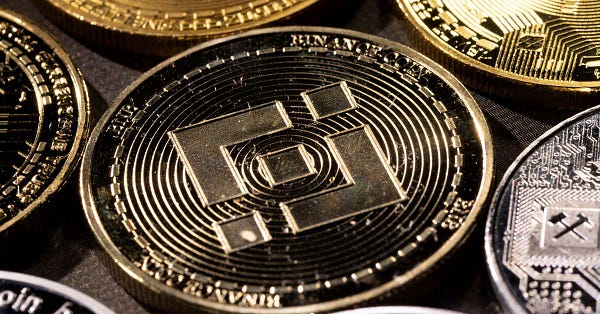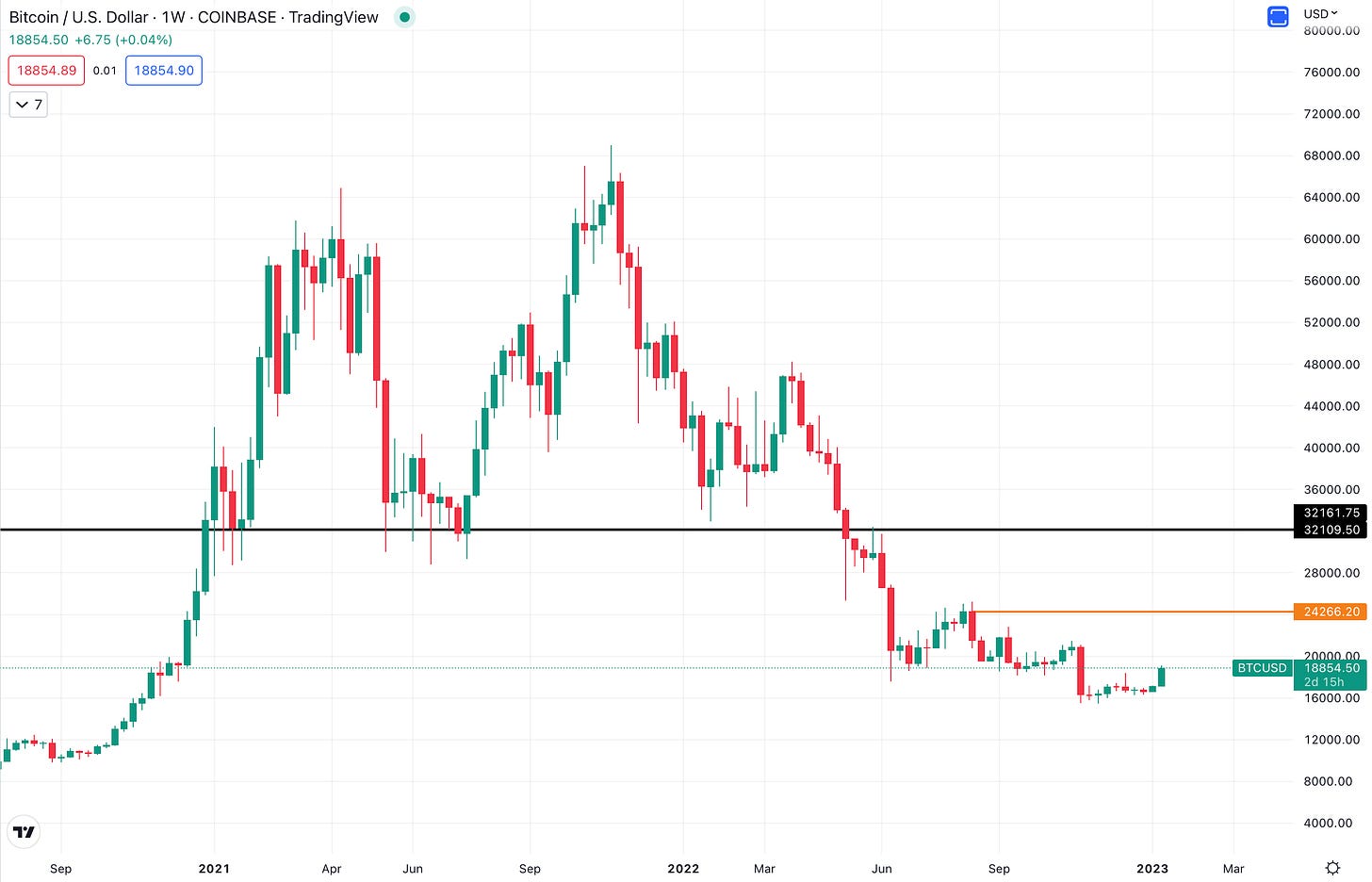Crypto 2023: 7 Predictions That Actually Take A Stance
We're so back! — P.S. sorry for the delay 👉👈
Disclaimer, NFA, all that legal stuff: All the information presented in this publication and its affiliates is strictly for educational purposes only. It should not be construed or taken as financial, legal, investment, or any other form of advice.
Hi folks 🙋🏻♂️,
Welcome to my annual crypto predictions. Today, we’ll unpack and pontificate on what will happen in crypto in the next twelve months. Remember, the point of these predictions is to catalyze conversations and crystallize our thinking about this space. Whether they come true or not matters less to me, but I’m still going to give it my all.
I hope to do these predictions every year until I no longer can 👴, maybe it will eventually expand into other areas I’m interested, but I digress. Let’s jump into it 👇

Today’s issue is brought to you by Chain Catalyst
Chain Catalyst is the best newsletter for web3 builders and investors 📰
Discover the next best web3 products, strategies, and trends - in just 5 minutes. You’ll be receiving the following, on top of a succinct coverage of news that matters.
Monday - charts of the week, product launches
Wednesday - case study, features & governance update
Friday - investor-builders highlight, funding update
I help write these issues 3x a week. If you want my quick thoughts on breaking news in crypto. Please consider subscribing :)
👉 CLICK HERE to read the latest issue
1. Crypto Reclaims $1.5T Market Cap, ETH Leads Rally
I’m no macro expert. I try my best to learn while not falling into the Dunning-Kruger effect that seems to be affecting any remotely successful person in the investment space these days, but I digress.
The crypto market is often ahead of TradFi. The common consensus is that the Federal Reserve will keep on raising rates for another percent or so, and keep it there until inflation subsides. If you have sustained capital and can keep on buying for two years, it might be a good time to start putting chips on the table.
Bitcoin is still ~37% of the total crypto market cap. Speculating on the size of the total crypto market cap is essentially speculating on the price of Bitcoin. Although I like to think that the major local bottom for Bitcoin is in, I don’t think Bitcoin will break the major resistance at $32,000 anytime this year.
Even if the price of BTC doubles from $17,000 to $34,000, it will only bring an additional ~$300 billion in total crypto market capitalization. Throw ETH doubling in price into the equation as well as other altcoins, we might be able to increase the market cap by ~$500 billion — taking it from ~$850 billion as of the time of writing to $1.3 billion.
ETH is the only asset that has sustained its strength against BTC for a long period of time. Frankly, how the ETHBTC ratio stays rangebound between 0.06-0.07 is fascinating to watch. With BTC miners capitulating and ETH yield becoming the risk anchor for crypto yield, I won’t be surprised if the ETHBTC ratio breaks and sustains above 0.1 in 2023. I think ETH will be the one that helps push the total crypto market cap to above $1.5 trillion.
2. BTC Mining Innovation: Climate Tech & Tokenization
Bitcoin miners are already capitulating because of the market downturn. Consolidations amongst miners have started as smaller miners are either downsizing, selling parts of their business, or filing for bankruptcy. Oh, there’s also this menace below but let’s pretend we don’t see it for a sec.

The point is, Bitcoin miners had to make sure they can cover expenses as the price of BTC went down, even below the cost basis that miners need to produce one BTC.
Historically, mining has not been that great of a business, especially Bitcoin mining. As the crypto industry matures, larger capital is necessary to enter the Bitcoin mining business, consolidating it amongst juggernauts which are typically a subsidiary of other crypto conglomerates such as DCG’s Foundry and Binance’s mining arm.
I can’t help to think that there’s a white space at the intersection of climate tech, green energy, Bitcoin mining, and the tokenization of carbon credits. I might write a whole post about this in the next few months, as it can get extremely complex.
The essence is utilizing cheap, easily accessible green energy to mine Bitcoin and tying that entire effort with tokenized carbon credits or by combining NFT technology to prove that the Bitcoin being mined is 100% clean.
Many other vectors and radical ideas can be implemented around Bitcoin mining but it’s an area often overlooked by crypto VC firms. The complexity will be about hedging the financial and operational risks as miners’ profits are directly tied to the price of BTC.
3. AppChain: More Top 20 Protocols by TVL Becoming AppChain
This one is pretty straightforward. The “blockchain layer” space is getting extremely saturated. We have multiple Ethereum layer 2 chains and alternative layer 1 chains competing with one another, all looking for that killer application to bring adoption to their chain.
These chains do this by providing ecosystem grants. Essentially a way to bribe (cough, I meant “incentivize”) founders and developers to build applications on their blockchain. This is a double edge sword that can either make or break the blockchain layer ecosystem.
Ethereum’s and EVM-compatible ecosystems survive because capital easily flows between these chains. Instant swapping between Ethereum, Ethereum layer 2, and EVM-compatible chains makes it easy for capital (Total Value Locked) to stay in the ecosystem. A completely alternative L1 chain like Solana doesn’t have this option.
Additionally, as liquidity dries and raising capital becomes more difficult. Crypto projects will be forced to think of new ways to generate revenue.
Becoming your own AppChain not only fits the investment narrative, but it accrues more value toward the underlying token associated with the project. Projects with PMF that need to scale will also look to weigh their options between grants from Ethereum L2, alternative L1, or becoming their own AppChain. We think more top 20 projects by TVL will become its own AppChain.

Take a look at Solana. Its largest NFT marketplace, Magic Eden, and non-custodial wallet, Phantom, has since expanded into another chain including Ethereum. Moreover, founders with leverage have also jumped ship when offered a better deal by other chains.
y00ts: it will move to Polygon. Polygon paid for the move with a grant from its partnership fund, with details to be disclosed at a later date. The grants will provide y00ts with 1-2 years of runway.
DeGods: it will move to Ethereum. CoinDesk reported a rumor that DeGods was seeking $5M from the Solana Foundation to stay on the platform. DeGods team denied this claim.
There's a fine line between becoming a pragmatic and mercenary founder in web3. Given Solana's bleak short-term outlook, one can't entirely blame the founders of y00ts and DeGods for finding alternatives to do right by their prior investors and community. NFT projects might opt more for grants as their focus is on brand building, while DeFi protocols will try to become AppChains. Always remember that a blockchain is just a tool for you to build your products. Don't marry the blockchains that you're building on.
4. Tokenized Real-World Assets (RWAs) Contribute $100 Billion
The number one valid criticism of crypto is that there is no real use case outside of speculation. While crypto’s number one potential is at increasing the velocity of capital (again, I’ll write a full post on this sometime soon), that need is more or less fulfilled by stablecoins, which arguably don’t have strong defensibility against CBDCs.
In order for crypto to truly become mainstream, it needs to touch everyday users’ lives. Those that don’t care about finance, trading, or technology need to be able to gain value from crypto applications.
“[insert company name] but web3” will take a while before it fully materializes and scales to the likes of Facebook. Alas, the most straightforward next step to take here is in bringing real-world assets into the blockchain. This increases transparency and reduces fees for the world’s financial plumbing, making it better for everyone (theoretically). However, this is impossible without some decentralization tradeoffs. After all, we still live under the rule of law.
A short story:


The trends of tokenizing RWAs have existed since the 2017 crypto bull market but in 2023 the regulatory frameworks and technology infrastructures needed might have finally caught up. There are projects like Ondo that are starting to tokenize US Treasuries and bonds.
The TAM: $50 trillion — for comparison, the total crypto market cap is less than 2% of the US Treasuries market. I predict that projects affiliated with tokenizing RWAs will contribute a total of $100 billion in market cap to the crypto market in 2023.
5. Regulatory Action Causes Flight to Emerging Markets
We’ve had a tough year in crypto. Bad (maybe overly greedy is a better term) actors were flushed out due to excessive leverage and hubris. One can argue that US regulators contributed to this by not being clear about its rules and framework around crypto. At the same time, it doesn’t take a genius to think that regulators around the world, especially developed markets, will use this negative momentum in crypto to strike and gain brownie points from politicians.
Don’t get me wrong, these bad actors should be prosecuted. However, I’m almost certain that developed markets regulators will over-regulate, further pushing crypto innovation abroad. Clear concerns about over-regulation are already showing, with a16z crypto releasing blogs such as the following.


Additionally, the DNAs of emerging market population is ripe to embrace crypto. Mobile wallets are common, awareness about trading and investing are on the rise, and a much weaker legacy financial infrastructure means that they’re open towards adoption. GCR, the famous trader that bet against the downfall of LUNA, predicted the following:

I believe that more top protocols (top 20 by TVL) will be moving abroad to emerging markets. They might not do it in one move, but the team, infrastructure, and entities related to the project will be slowly decentralizing abroad.
6. Crypto Goes Mobile-First via GameFi, Southeast Asia Leads Adoption
Gaming is a large industry. I’m not going to spend more time expanding on this but here’s a quick chart if you’re not convinced. It’s the only industry that tech giants are entering because the TAM is big enough and the growth is marvelous.
If you’re under 25 and have spent some parts of your childhood in Asia, this prediction might sound very obvious. I remember spending too much of my time and money when I was a teenager on MMORPGs. Those were the days. Fast forward to my college days, I stopped playing online games because they took to much time and started playing one-off big title such as God of War and Witcher 3 instead.
During class however, I remember college kids playing mobile games. In the west, it was Supercell games such as Clash of Clans (Supercell revenue was $2.24 billion in 2022). When I traveled to the east during breaks, the mobile gaming scene was much more thriving. I saw kids in the mall playing various genre of mobile games (MOBA, MMORPG, FPS). There was not one company or game IP that I recalled truly dominating the market. Asia is clearly much more obsessed about mobile games.
How do we tie crypto and mobile adoption into all this?
Crypto needs to go mobile-first to reach more users.
Apple and iOS is making it difficult to create decentralized applications on mobile phones.
Emerging markets, especially Asia and Southeast Asia, use Android. In 2022, 84% of mobile phone in Asia are Android-base.
It’s pretty straightforward. Create a truly amazing game, then slowly decentralize and add web3 components into it. Focus on product. Don’t try to do savvy financial engineering by emphasizing the play-to-earn aspect. Just create a damn good game.
Why Southeast Asia? That’s where the growth are and because you won’t be kneecapped by Apple and iOS for every single update. Sure east asian countries like China, Korea, and Japan would contribute a lot to the TAM, but you’re also competing with much more highly capitalized game companies.
Need one more argument? Southeast Asia population is increasing. They have significantly more young people that will enter the workforce, contributing to the rise of its middle class. I don’t think I need to explain why that isn’t the case for China and Japan.
7. Binance Record Breaking Settlement
This one doesn’t require a lot of explanation. Tether has had its fair share of battles with US regulators, but I think Binance will do a record-breaking settlement with US authorities. Too many breadcrumbs have been left behind.


My prediction is simply that it will be a record breaking settlement.
Binance did $30 trillion of volume in both 2021 and 2022.
1 bps revenue means $3 billion per year
This is not counting its launchpad, venture/labs arm, staking, earn, custody, market maker, stablecoin, binance chain, yada yada yada.
A $1 billion settlement is very plausible.
If you enjoy this predictions, kindly give me a follow on Twitter below for more quick takes on the crypto market.
Until next time,
Marco M.
















